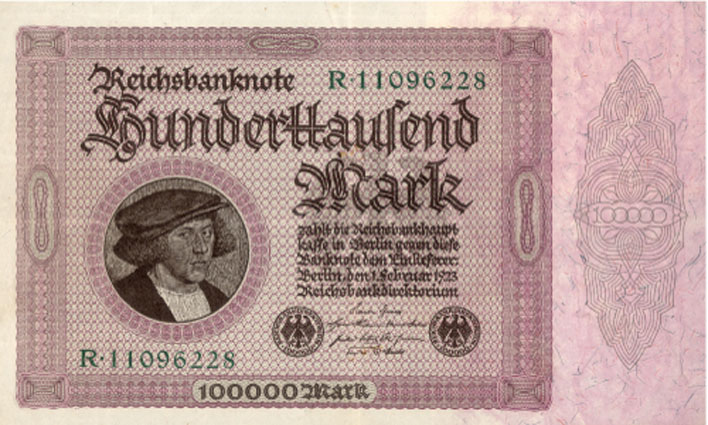Personal Wealth Management / Market Analysis
Book Review: ‘Get Them to Blink In Sequence’—James Rickards' Currency Wars
James Rickards' Currency Wars: The Making of the Next Global Crisis is ambitious but falls far short of adding material value for investors.
Was this 1923 German mark actually part of Currency War I’s opening shot? Photo by Getty Images/Hulton Archive.
Currency Wars: The Making of the Next Global Crisis, James Rickards
In one small slice of perhaps Hollywood's greatest scene, Airplane II's Buck Murdoch (William Shatner)—Lunar Base Alpha-Beta commander—is notified of troubles aboard the inaugural flight of commercial Space Shuttle Mayflower. After a quick briefing, Murdoch's aide-de-camp notes the dozens of lights on a computer panel "keep blinking out of sequence." He seeks Murdoch's advice ... what should they do about these out-of-sequence lights? Murdoch replies stoically: "Get them to blink in sequence." Order is preferential to the chaos of random blinking. James Rickards' Currency Wars seemingly demonstrates the same desire for order. What's left is an ill-defined theory with a striking lack of actual hard evidence and a bizarrely contradictory conclusion.
Currency Wars argues a new, primarily three-front currency war began in 2010—one with potentially disastrous consequences, like a collapsing dollar, cratering stocks and bonds and a global recession. To tell the tale, the reader is led through a comprehensive review of Currency Wars I and II (CWI, 1921-1936 and CWII, 1967-1987). Now, you might be inclined to ask: What defines a currency war?
A good question. At various points throughout the book, a currency war is defined as any of the following: A competitive devaluation; a domestic monetary policy with a devalued currency as a consequence; an outright financial attack; elimination of the dollar's reserve currency status; a sudden crash of the dollar's relative value stemming merely from many seemingly unrelated decisions by various global investors; and, simply, mutual dependence. A fairly wide net encompassing nearly any interest-rate change or policy actually or seemingly impacting a currency's relative strength is a potential "weapon." In Currency Wars, the Fed's quantitative easing is identified as the weapon triggering the present conflict. (More on that in a moment.)
Given this expansive definition of currency wars, it's unsurprising the book seems to fall prey to a behavioral bias—order preference. Currency Wars assembles an impressive array of factoids and historical happenings to illustrate how dire CWI and CWII were. Yet there is little real evidence of a connection or an overarching strategy at the time. For example, the book claims Weimar Germany's hyperinflation in the early 1920s was an intentional effect designed to boost Germany's standing economically—the opening shot of CWI. And maybe that's true! But there is only the assertion. No supporting evidence. The book cites the events or happenings to two other books—one describing the scope of the hyperinflation, the other the aftermath. The "weapon" assertion is unique to Currency Wars and leaves one wanting a citation, a quote to official memoranda ... or really anything. Considering the suffering Weimar hyperinflation wrought on Germany particularly, it seems this currency weapon—if it actually was that—unexpectedly boomeranged ... or this was just bad policy. (That the struggling-to-survive Weimar government was British- and French-backed is not addressed.) In my view, the author bears the burden of proof here, yet none is provided—a common problem with Currency Wars. Seen in this light, the book's assertions regarding currency wars past fall a bit flat, not to mention the book's theory regarding the present and future.
The book assembles all these events and sees them through a currency war lens—seemingly arranging factoids in a fashion fitting the thesis a currency war was afoot, ignoring the entirely plausible counterargument there was absolutely no strategy or plan, just some events. And other directly currency-related events were curiously omitted. For a couple examples, there is a brief discussion of Long-Term Capital Management's (LTCM) 1998 demise tied to the Asian Currency Contagion/Russian Ruble Crisis—in which Rickards was directly involved as LTCM's counsel—but this episode isn't part of an identified currency war. Interestingly, the book touches on 2008's financial panic frequently, but this, too, isn't part of a currency war. Finally, while QE2's launch (2010's version) starts Currency War III—and is supposedly the "ultimate currency war weapon"—QE1 (2008's version) gets scant mention in the book. The unsupported inclusions and curious omissions give the sense the book is trying to “get the lights to blink in sequence.”
Even the premise QE is somehow the ultimate currency war weapon is sketchy (at best). The book asserts US QE is an attempted currency manipulation. With the passage of time, we can now look to markets to grade this. Relative to a trade-weighted basket of currencies, the dollar fell only in the very, very short term when QE2 was announced on November 3, 2010. The dollar is higher today. And that's after Operation Twist, QE3 and QE-infinity. If the Fed's goal was dollar devaluation relative to other currencies (a beggar-thy-neighbor policy), suffice it to say, mission not accomplished; neighbor not beggared. The book goes further, claiming QE devalued the dollar relative to gold. But gold's upturn began before QE (early 2000s) and, ironically, a gold bear market began a few months before Currency Wars first hit bookstores in November 2011.
Currency Wars’ conclusion is a currency catastrophe is avoidable, but only with a new gold-backed dollar. It needn't be the traditional gold standard, where X dollars strictly equal an ounce of gold—the book's proposed standard has loopholes for emergencies. This, or possibly the brief behavioral economics discussion, is perhaps the book's best part. I don't support a gold standard, but the discussion of how a modernized gold standard would work—and the excessive blame some pin on the old gold standard for the Great Depression—makes for interesting reading.
However, the application to preventing currency wars is curious. The goal, Currency Wars argues, is stability. Readers are told policymakers (the Fed, Congress, et al) were responsible for historical currency wars and today’s supposedly fragile dollar—instability. Yet Currency Wars' gold standard would put the dollar's value in the same politicians' hands to an even greater extent, something unpegged, market-traded currencies mitigate. Currencies do chase interest rates somewhat, giving policymakers an influence, but liquid markets are much more stable and self-correcting than the book acknowledges. The more liquid, the less effective the currency-manipulation attempt. Unless an artificial peg is added ... like a gold peg.
The American historical experience also argues a gold standard is highly polarizing and destabilizing (see William Jennings Bryan, "Cross of Gold"). And it is subject to manipulation by elected officials whose jobs hinge on popularity. The modernized Currency Wars structure allows for elected politicians to declare "Emergency!" and suspend the gold peg—reason being, it allows for Fed intervention in panic while adding democracy to monetary policy. But it actually politicizes policy too, potentially bringing far worse results than the Fed's. After all, elected officials' fingers would press the crisis button, and my guess is anything threatening their reelection is subject to a "crisis of epic proportions" label. And that's without getting into the question of their economic wisdom and judgment, which frankly, you'd think Currency Wars would reject given the book's stance on QE. Lastly, there is scant evidence a gold standard ensures a stronger, less panic-prone financial system. The 19th and early 20th centuries had the gold standard (classical form) and a simpler banking system—and repeat, endemic financial panics. The book doesn't address this whatsoever. I agree with some of the Fed criticism. The Fed's history is far from perfect. But similar—if not greater—criticisms can be levied against the gold standard, even this modified version.
The book closes with a wildly speculative vision of complete dollar collapse based on the public rejecting dollars. Readers are led from one highly improbable event to another, with no cause, no reason why the events are occurring, no relationship from event to event. Pension funds in the Netherlands just wake up one morning, yawn, and liquidate all their dollar holdings. It is a many-step leap of faith from point to point. The discerning reader, the typical MarketMinder reader, will be left wanting by this—true of the book generally. Forcing the lights to blink in sequence, it seems, isn't the core of a good financial read.
If you would like to contact the editors responsible for this article, please message MarketMinder directly.
*The content contained in this article represents only the opinions and viewpoints of the Fisher Investments editorial staff.
Get a weekly roundup of our market insights
Sign up for our weekly e-mail newsletter.

You Imagine Your Future. We Help You Get There.
Are you ready to start your journey to a better financial future?

Where Might the Market Go Next?
Confidently tackle the market’s ups and downs with independent research and analysis that tells you where we think stocks are headed—and why.






